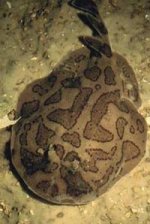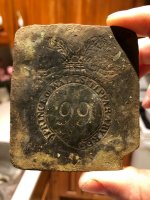toddbbq
Hero Member
In my past 4 trips to the gulf beaches with my EQ800 I have been in the water between waist and chest high. I am moving along slowly and had an iffy target with the TID bouncing between 1 and 3 so I decide to scoop it and as soon as my scoop hit the bottom a brown blur scoots out from under my coil spooking me pretty good as I was not anticipating a stingray  . I rescan the target and its gone? This morning it happened again I put the scoop on the bottom and out comes another dark brown stingray and the targets gone. Come to find out the stingray is ELECTRIC and my detector can find them lol. Here is some info on the critter.
. I rescan the target and its gone? This morning it happened again I put the scoop on the bottom and out comes another dark brown stingray and the targets gone. Come to find out the stingray is ELECTRIC and my detector can find them lol. Here is some info on the critter.

LESSER ELECTRIC RAY
Narcine bancroftii
Lesser Electric Ray
Identification
Grayish to reddish brown, with many rounded dark blotches that are outlined with blackish circles on the dorsal disc. Disc white ventrally. Round disc with a thick tail and well developed dorsal fins and caudal fin. No spine on tail. Two electric organs, set on either side of the head, are visible ventrally as kidney shaped “honeycombs”.
Habitat and Behavior
A demersal or benthic species inhabiting coastal waters, on sand or mud bottoms. Commonly found partially buried along sandy shorelines, seagrass beds, and sometimes near coral reefs. Found from the surf zone up to 200 feet.
Size
33 inches total length
Human Factors
Non-aggressive species of little danger to humans. Can discharge a shock between 14 and 37 volts, primarily used for defense. Contact with the disc in the pectoral region can produce a mild electric shock, not enough to injure a human.
 . I rescan the target and its gone? This morning it happened again I put the scoop on the bottom and out comes another dark brown stingray and the targets gone. Come to find out the stingray is ELECTRIC and my detector can find them lol. Here is some info on the critter.
. I rescan the target and its gone? This morning it happened again I put the scoop on the bottom and out comes another dark brown stingray and the targets gone. Come to find out the stingray is ELECTRIC and my detector can find them lol. Here is some info on the critter.
LESSER ELECTRIC RAY
Narcine bancroftii
Lesser Electric Ray
Identification
Grayish to reddish brown, with many rounded dark blotches that are outlined with blackish circles on the dorsal disc. Disc white ventrally. Round disc with a thick tail and well developed dorsal fins and caudal fin. No spine on tail. Two electric organs, set on either side of the head, are visible ventrally as kidney shaped “honeycombs”.
Habitat and Behavior
A demersal or benthic species inhabiting coastal waters, on sand or mud bottoms. Commonly found partially buried along sandy shorelines, seagrass beds, and sometimes near coral reefs. Found from the surf zone up to 200 feet.
Size
33 inches total length
Human Factors
Non-aggressive species of little danger to humans. Can discharge a shock between 14 and 37 volts, primarily used for defense. Contact with the disc in the pectoral region can produce a mild electric shock, not enough to injure a human.
Upvote
0








